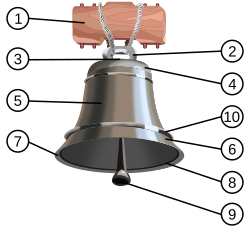Bell

Parts of a typical tower bell hung for swinging: 1. yoke, or headstock 2. canons, 3. crown, 4. shoulder, 5. waist, 6. sound bow, 7. lip, 8. mouth, 9. clapper, 10. bead line
|
|
| Percussion instrument | |
|---|---|
| Classification | struck idiophone |
| Hornbostel–Sachs classification | 111.242 (Bells: Percussion vessels with the vibration weakest near the vertex) |
| Playing range | |
| From very high to very low | |
| Related instruments | |
| Chimes, Cowbell, Handbell, Gong | |
A bell is a simple idiophone percussion instrument. Although bells come in many forms, most are made of metal cast in the shape of a hollow cup, whose sides form a resonator which vibrates in a single tone upon being struck. The strike may be made by a "clapper" or "uvula" suspended within the bell, by a separate mallet or hammer, or—in small bells—by a small loose sphere enclosed within the body of the bell.
Bells are usually made by casting metal, but small bells can also be made from ceramic or glass. Bells range in size from tiny dress accessories to church bells 5 metres tall, weighing many tons.
Historically, bells have been associated with religious rituals, and are still used to call communities together for religious services. Later, bells were made to commemorate important events or people and have been associated with the concepts of peace and freedom. The study of bells is called campanology.
A set of bells, hung in a circle for change ringing, is known as a ring or peal of bells.
A set of 23 bells spanning at least two octaves is a carillon.
Bell is a word common to the Low German dialects, cognate with Middle Low German belle and Dutch bel but not appearing among the other Germanic languages except the Icelandic bjalla which was a loanword from Old English. It is popularly but not certainly related to the former sense of to bell (Old English: bellan, "to roar, to make a loud noise") which gave rise to bellow.
...
Wikipedia
